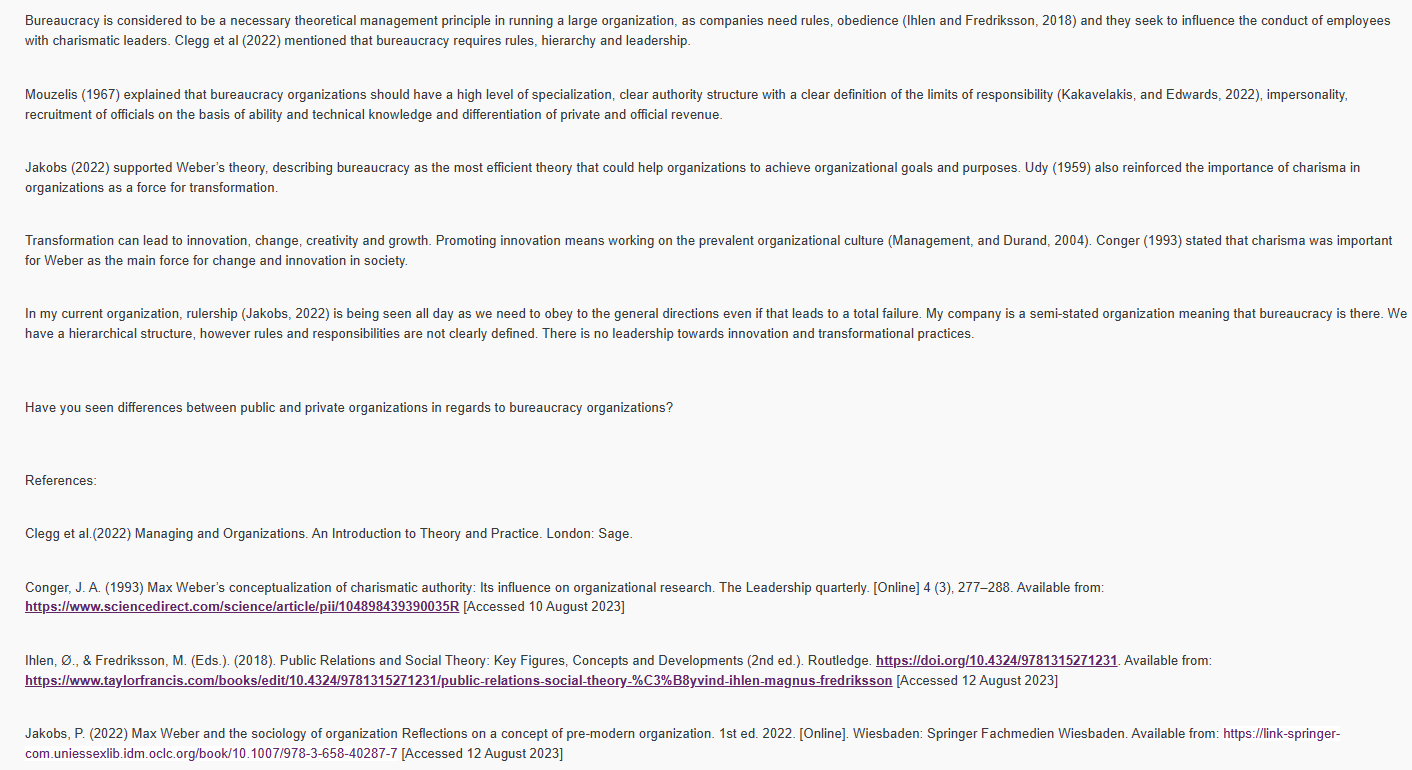Question
- I need to replay/ Respond for the following discussion below. - 200-300 words - Harvard System Reference - Support the replay with a References
- I need to replay/ Respond for the following discussion below.
- 200-300 words
- Harvard System Reference
- Support the replay with a References from your own and examples and experiences. ( 3 References)
- References to be within the UK
The discussion:
Bureaucracy is considered to be a necessary theoretical management principle in running a large organization, as companies need rules, obedience (Ihlen and Fredriksson, 2018) and they seek to influence the conduct of employees with charismatic leaders. Clegg et al (2022) mentioned that bureaucracy requires rules, hierarchy and leadership.
Mouzelis (1967) explained that bureaucracy organizations should have a high level of specialization, clear authority structure with a clear definition of the limits of responsibility (Kakavelakis, and Edwards, 2022), impersonality, recruitment of officials on the basis of ability and technical knowledge and differentiation of private and official revenue.
Jakobs (2022) supported Weber's theory, describing bureaucracy as the most efficient theory that could help organizations to achieve organizational goals and purposes. Udy (1959) also reinforced the importance of charisma in organizations as a force for transformation.
Transformation can lead to innovation, change, creativity and growth. Promoting innovation means working on the prevalent organizational culture (Management, and Durand, 2004). Conger (1993) stated that charisma was important for Weber as the main force for change and innovation in society.
In my current organization, rulership (Jakobs, 2022) is being seen all day as we need to obey to the general directions even if that leads to a total failure. My company is a semi-stated organization meaning that bureaucracy is there. We have a hierarchical structure, however rules and responsibilities are not clearly defined. There is no leadership towards innovation and transformational practices.
Have you seen differences between public and private organizations in regards to bureaucracy organizations?
References:
Clegg et al.(2022) Managing and Organizations. An Introduction to Theory and Practice. London: Sage.
Conger, J. A. (1993) Max Weber's conceptualization of charismatic authority: Its influence on organizational research. The Leadership quarterly. [Online] 4 (3), 277-288. Available from: https://www.sciencedirect.com/science/article/pii/104898439390035R [Accessed 10 August 2023]
Ihlen, ., & Fredriksson, M. (Eds.). (2018). Public Relations and Social Theory: Key Figures, Concepts and Developments (2nd ed.). Routledge. https://doi.org/10.4324/9781315271231. Available from: https://www.taylorfrancis.com/books/edit/10.4324/9781315271231/public-relations-social-theory-%C3%B8yvind-ihlen-magnus-fredriksson [Accessed 12 August 2023]
Jakobs, P. (2022) Max Weber and the sociology of organization Reflections on a concept of pre-modern organization. 1st ed. 2022. [Online]. Wiesbaden: Springer Fachmedien Wiesbaden. Available from: https://link-springer-com.uniessexlib.idm.oclc.org/book/10.1007/978-3-658-40287-7 [Accessed 12 August 2023] Kakavelakis, K. & Edwards, T. J. (2022) The Impact of Structure and Corporate Ideology on Leader-Follower Relations in the Bureaucratic Organization: A Reflection on Moral Mazes. Journal of business ethics. [Online] 181 (1), 69-82. Available from: https://web-s-ebscohost-com.uniessexlib.idm.oclc.org/ehost/pdfviewer/pdfviewer?vid=0&sid=e5422a0e-2733-4d2a-9133-2533782ffafc%40redis [Accessed 9 August 2023 Management, E. I. for T. and I. & Durand, T. (2004) Bringing Technology and Innovation into the Boardroom Strategy, Innovation and Competences for Business Value. 1st ed. 2004. [Online]. London: Palgrave Macmillan UK. Available from: https://link-springer-com.uniessexlib.idm.oclc.org/chapter/10.1057/9780230512771_3 [Accessed 10 August 2023] Mouzelis, N. P. (1967) Organization and bureaucracy?: an analysis of modern theories. London?;: Routledge. Available from: https://www-taylorfrancis-com.uniessexlib.idm.oclc.org/books/mono/10.4324/9781315125879/organization-bureaucracy-nicholson [Accessed 10 August 2023]
Udy, S. H. (1959) 'Bureaucracy' and 'Rationality' in Weber's Organization Theory: An Empirical Study. American sociological review. [Online] 24 (6), 791-795. Available from: https://www.jstor.org/stable/2088566?casa_token=PyS8WsHi7kEAAAAA%3A744gWyTi5MVOiKguz2b1k9rL2FhkQcPEFCCA2adryHEBnre06dCKKUhQmobro0cd0gC8MVAn6Gx8b4O-_jD-jBRsgt4iX4Iyf8IlySsADxuZLLdQPg [Accessed 10 August 2023]

Step by Step Solution
There are 3 Steps involved in it
Step: 1

Get Instant Access to Expert-Tailored Solutions
See step-by-step solutions with expert insights and AI powered tools for academic success
Step: 2

Step: 3

Ace Your Homework with AI
Get the answers you need in no time with our AI-driven, step-by-step assistance
Get Started


